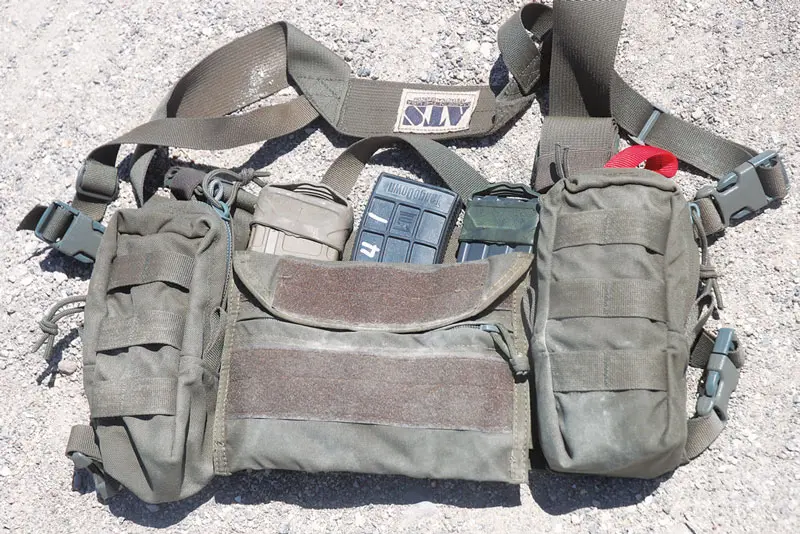
In the February issue, I covered working from your war belt during a carbine class. Now I’ll look at the vest as well as the bag, but let’s make something clear from the start.
Within the overarching group that seeks out training, several sub groups exist. The first sub group comprises those who work within the military and law enforcement communities, and they will train with the gear they use on the job. A second sub group trains because they want to, and may include various sub sub groups.
One sub sub group is the “purists.” These guys will make a show of stating that they will only use in training what they would actually “use” for real. To this end, they will attend a carbine class and work from pockets as well as insidethe- waistband holsters for their pistols, again stating this is how they would “have” to fight.
This is good as far as it goes—but maybe it doesn’t go far enough.

Table of Contents
HERE’S HOW IT IS
Here is a news flash. Well, two news flashes. The first is that most cops never fire their pistols at anyone, ever. Even fewer shoot their carbines at someone. And the number of civilians who have legally used a carbine against another is so small as to be insignificant.
But we train for the worst-case eventuality. In order to do that properly, we need to have a solid grasp of the basics so we can function in reality. Certain Tactics, Techniques, Procedures and Equipment (TTPE) will enhance this, while others will detract from it.
At my training entity, EAG Tactical, we don’t force people to wear any one method of carriage for carbine magazines, although we don’t allow certain types of holsters (inside-the-waistband holsters, to be specific) in the class for reasons of safety and efficiency.
We want the class to move efficiently, with all hands functioning at approximately the same pace. Some issues we have faced in the past are directly related to those who want to keep magazines in various trouser or shirt pockets across their body. This often results in clumsy and inefficient handling of magazines, and often the carbine itself.
We need to clearly understand that mastering the basics is necessary. There is no such thing as an advanced gunfight. We must be able to perform the basics under all circumstances and conditions.
The second news flash is that an average earth person—even if they do engage with a long gun—may never fire more ammunition than what is on board the gun.
So stuffing your pockets at a course is no more viable than wearing a chest rig. It will just be more inefficient.
CHEST RIG DEVELOPMENT
I’ll suggest that the chest rig—a proper one, and adjusted correctly—will provide a convenient and efficient way to work your carbine at class.
If you want to work your pockets, you can do that on your own time, when you have the time to learn how to do it correctly. I have no problem with students in follow-on classes using bags they have previously worked with at home, as well as using pockets.
Chest rigs first popped up—albeit in very limited numbers—in World War II, and became general issue among communist troops in the early 1960s. They became popular when Rhodesian troops used modified chest rigs in their losing war against the communists, and gained more popularity in the U.S. with the issuance of the RACK—Ranger Assault Carry Kit—in the early 2000 time frame.
The RACK—as well as various Rhodesian Rigs and others—was meant to be worn either alone or over existing armor packages, and meant to carry a large amount of mission-essential gear.
It was, like most gear at the time, strongly made of 1000d Cordura® and designed to be bombproof. It was no doubt overbuilt, and the result was often a large unit with a multitude of pouches to carry everything from a buttload of magazines to water, radios, sketch kits, and probably two-stroke small-engine repair kits.
TODAY’S CHEST RIGS
The current (and it will be for a generation or so) War on Terror brought a lot of theory face to face with reality. Improved armor packages, better design and manufacturing, and more importantly experience gained on the battlefield have rendered RACK-type chest rigs superfluous at this time.
However, if we once more get involved in those steamy triple-canopy jungles of Asia and the Pacific, we may see a resurgence of the RACK rig.
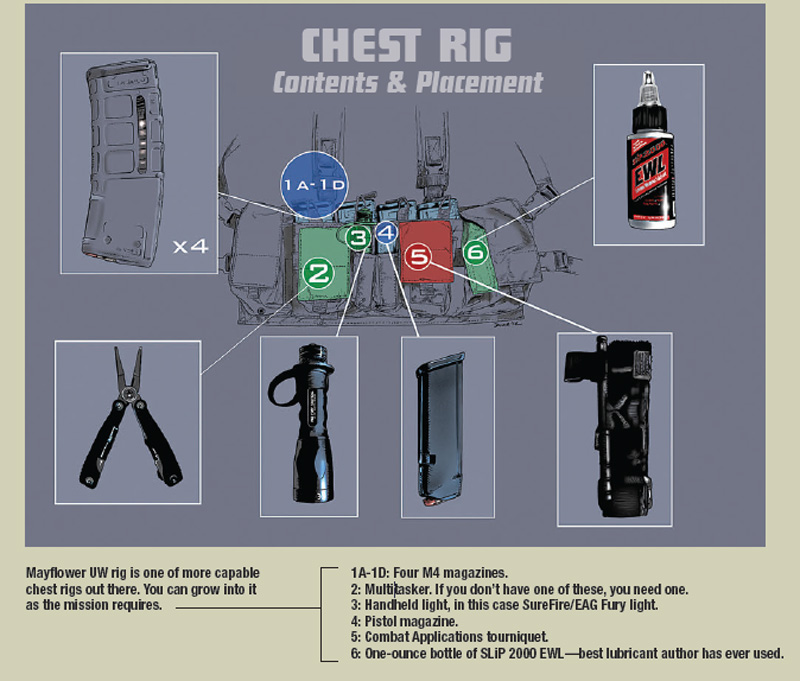
What I’ll cover here are chest rigs that a student would wear on a square range class (but might also wear over armor when necessary). This current crop of chest rigs is smaller, lighter and more user friendly, making them more useful for our purposes at class.
You should not fight your equipment. The gear has to work for you, not the other way around. The way to make that happen is to purchase something that meets your mission requirements.
Students often show up with gear they bought at a local tactical store or after an Internet search, and the result frequently is a poorly designed, cheaply made item that may not be viable for the class.
The problem is that many do not know what they do not know, and the way to gain the requisite knowledge is to ask. The instructor teaching the class is the best bet, but other sources of information, such as after-action reports on forums such as Lightfighter, can provide a wealth of info from students who have attended certain classes.
From my perspective, you want a vest that can hold three or four M4 magazines and possibly an accessory pouch. You can of course go up in complexity, but you don’t want to overload it.
I have used a number of chest rigs over the years and have seen a plethora of others used by students in class … so I have a fair idea of what works. The following is a sample and not all-inclusive. If your favorite piece of gear is not included, it may not mean it sucks (though it might). It may just mean I haven’t seen enough of them to have an opinion.
WHAT YOU NEED
If you are armed with a pistol and carrying a War Belt (WB), some of these items may be carried there.
- Two to five M4 magazines (actual number is determined by the type of course)
- Two pistol magazines (WB)
- Multitasker (WB)
- Tourniquet (not required but strongly recommended)
- Handheld light (WB) (not required for all classes but recommended)
- Accessory pouch (to hold bottle of lube)
- Individual First Aid Kit (WB or fanny pack) (not required but strongly recommended)
CHEST RIGS
ATS Tactical
ATS Tactical has long been a supplier of good quality kit. They make a number of chest rigs that fit most requirements. Among those that I like are the Low Pro Chest Rig and the newer Split Front Chest Rig.
The Low Pro Chest Rig is made from 500-denier nylon and has three single M4 magazine pockets and two utility pouches. The ATS Medical Insert can fit nicely into one of these pouches, which makes it value added. Additional M4 magazines can be carried in a utility pouch as well. It is lightweight, comfortable and capable. I have a lot of time wearing one and believe it is an excellent rig.
The Split Front 5.56 is a new offering by ATS. It has two single M4 pouches on each side, and a skeleton-type MOLLE panel that permits the user to add mission- essential equipment.
Keeping the front slick permits you to get low to the deck when necessary and remain prone with relative comfort over a long period of time. It can also reduce your profile if you are in plainclothes. This will become a very popular item.
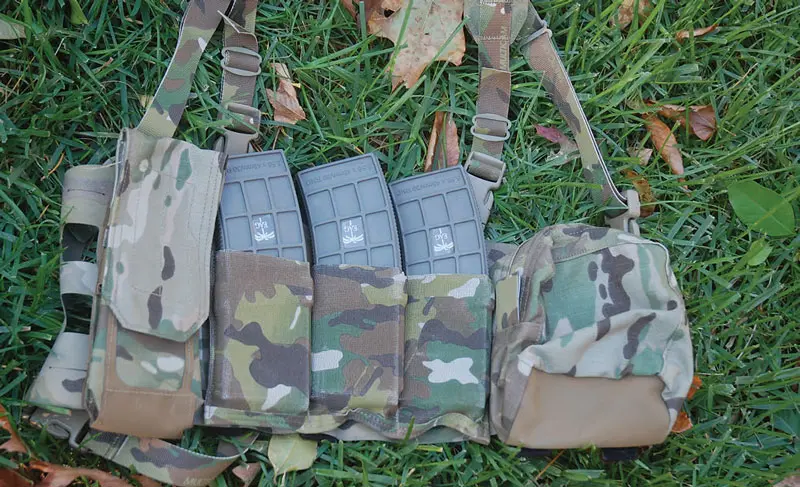
Blue Force Gear
Blue Force Gear has what may be the simplest, as well as the lightest, chest rig out there—the 10 Speed M4 Chest Rig. This is a minimalist rig in the truest sense, with multi-use pouches made from elastic.
The four elastic pouches are designed to take one M4 magazine each, but they will take anything that will fit, including radios and med equipment. There are MOLLE panels on each side of the rig to accommodate other missionessential gear.
When I received the very first 10 Speed magazine pouches several years ago, I was concerned about their longevity, but they have far exceeded expectations. Reinserting magazines is somewhat more difficult than extracting them, but it is a minor issue when you consider the reduced weight and bulk.
We keep several of these in the Death Star for students who bring crappy gear to class. When the cheap rig they bought doesn’t work as they expected, they accept the loan of this and often want to buy it on the spot.
A more innovative minimalist rig, also from Blue Force Gear, is the RACKminus. Based on the MOLLE minus platform, it is extremely light, weighing about half what a single loaded M4 magazine does. This platform is made of a composite high-strength material called Ultra Comp, which can be cut into the requisite pattern rather than having a number of pieces sewn together. This clearly saves weight and bulk, and makes a lot of sense.
The RACKminus requires the user to add the pouches he wants—a smart move for those who can be trusted not to overload their gear.
This is an excellent rig and is currently my go-to chest rig for class.
Bravo Company USA
Bravo Company sells the BCM/03 Split Front Chest Rig, designed by Pueblo, Colorado SWAT Detective Jeff Carpenter as a vest that can be used for plainclothes police work as well as training. It has a very wide range of adjustments to permit its use across the broad spectrum of body styles and configurations.
The BCM/03 Split Front Chest Rig can be worn over armor but under a jacket to reduce your profile while allowing you to carry a full mission load. The clean front also allows access to the M4 magazines while in prone, and less discomfort in prone over long periods of time. Jeff did a great job designing this, and it is a true labor of love.

Mayflower Research & Consulting
Mayflower makes an exceptionally capable chest rig called the UW. This chest rig is not simplistic, but instead complex.
The UW rig comes with a variety of sewn-in pouches, including four M4 magazine pouches, two pistol magazine pouches, two radio pouches, and two utility pouches. The design allows the unit to be ambidextrous. The UW chest rig may be more than you need for a basic carbine course, but it also allows you to grow into it.
BAGS
I seldom see a bag at class, but from an operational standpoint, it’s a sound choice. It permits the user to carry mission-essential equipment in a convenient package. A lot of cops carry a bag of one type or another that has extra magazines, radio batteries, additional medical supplies, and so forth.
As the purpose is to backfill a chest rig and provide additional equipment in the event of a catastrophic event, such as an extended hostage job, riots, or a Mumbai-type event, some cops are calling this a BOD (Bag of Doom). It makes perfect sense to me, although a lot of police administrators have their heads buried deep in the sand. It is encouraging that some cops are taking it upon themselves to move away from the “It can’t happen here” syndrome.
However, the bag is used by some as a chest-rig surrogate. In this case, carrying gear other than magazines can be a double-edged sword. While it is nice to be a purist and chant, “This is how I will fight,” superfluous equipment within the bag makes accessing the magazines difficult, which in turn makes running the gun more difficult. It may make more sense to run the bag slick so as to maximize learning, especially in initial training classes.
After that, you can add other equipment as required, and it won’t interfere with your learning, or the learning of others.
A bag will generally be slung over the support-side shoulder. The bag has a tendency to flop around a bit if you use only a shoulder strap.
Duke Krieger (who illustrates my articles) has a tip worth passing on. He replaced the OEM strap on his Mayflower E&R Bag with a Viking Tactics VTAC sling. This sling is rapidly adjustable across a wide range, and snugged up tight makes life a lot easier when trying to work the bag.
Magazines need to be constrained in pouches. If you leave them flopping around loose in the bag, you will either have difficulty finding them or you will grab each one in a different manner, screwing up your reloads royally.
One bag I have seen multiples of and that works well for users is the Mayflower Research & Consulting E&R Bag. It is a semi-large bag with magazine pouches for six M4 magazines as well as multiple other compartments for additional mission-essential gear. Like all of Mayflower’s kit, it is well designed and made.
RESEARCH AND TESTING
What you think is perfect today may not be as wonderful at the end of a threeday class. Research what is available and make decisions based on how you are going to use that particular piece of equipment. Once you have made the purchase, load the equipment as you would when you go to class.
Then put on all (as in all) your gear, including weapons. Make sure you can access everything you carry. If not, take the time to de-conflict it at home. Nothing exists in a vacuum, and adding or deleting a single piece of gear will change how you do business a lot more than you might think. If you wait until you get to class to do this, you will just make life miserable for yourself as well as the other students.
All the rigs mentioned above have been used by me or my students, and they all work very well. The companies are top shelf and stand by their work. Buying something that is less expensive is probably not going to be the best value.
The search for perfect gear is neverending.
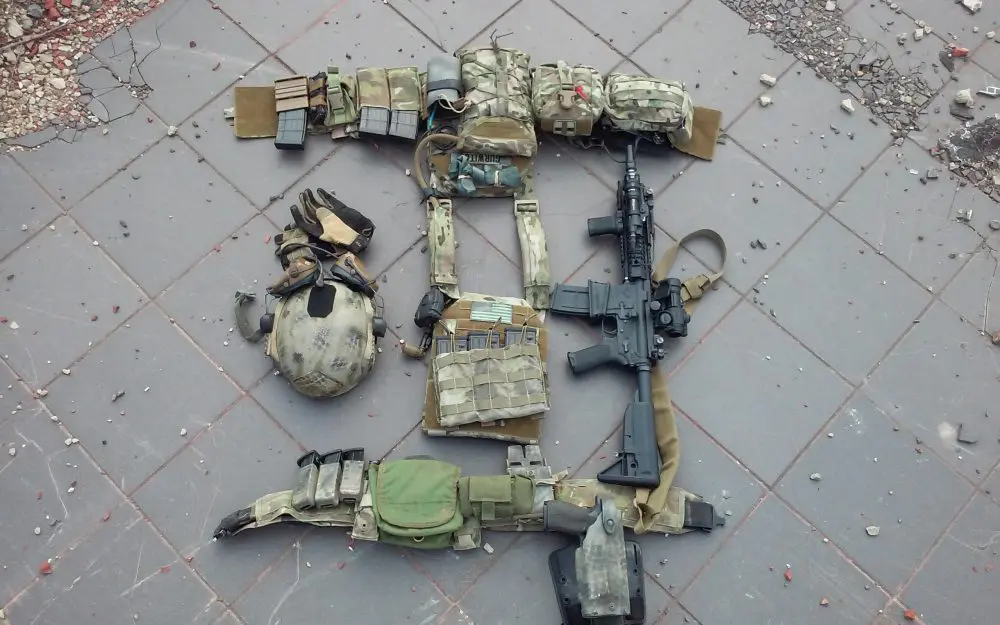
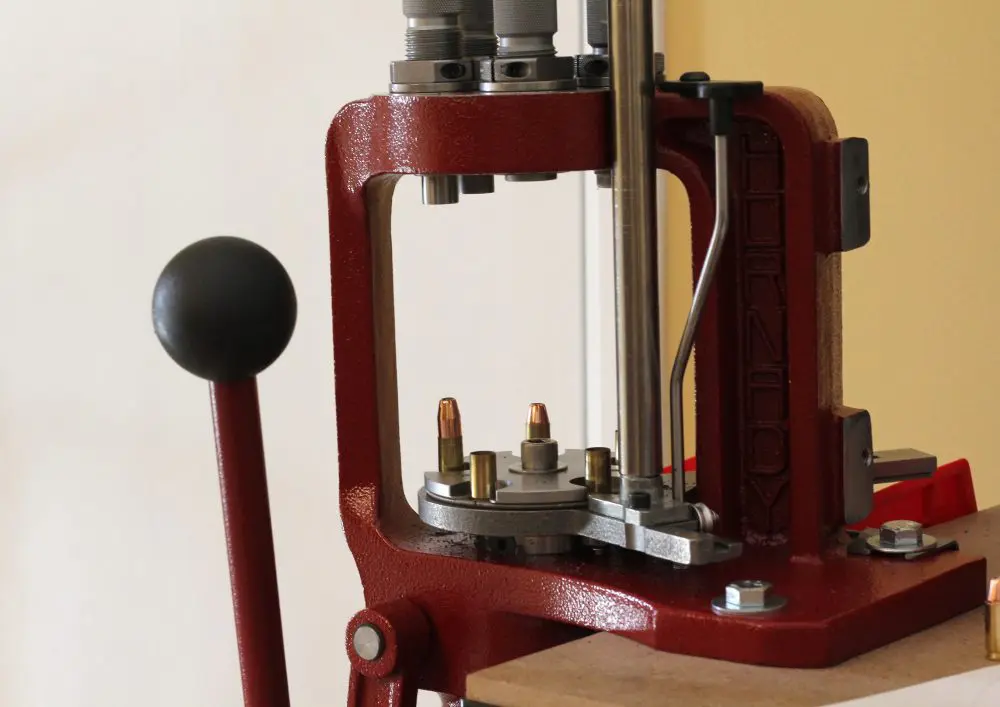
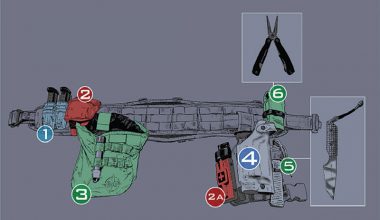

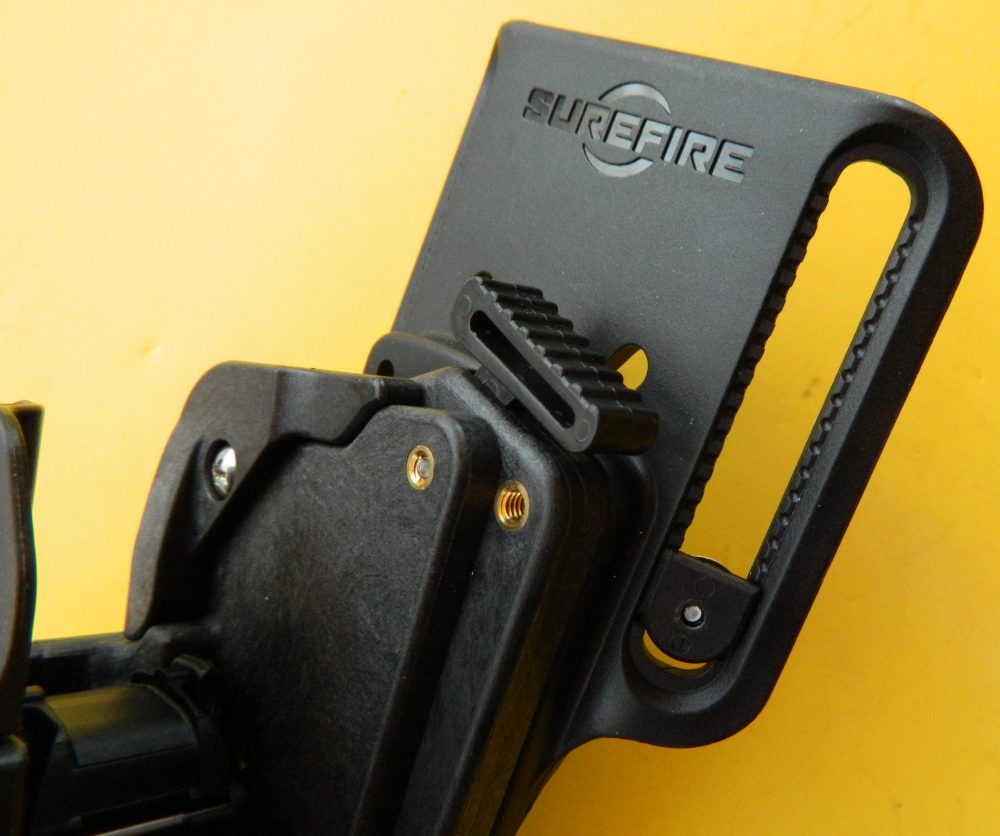

1 comment